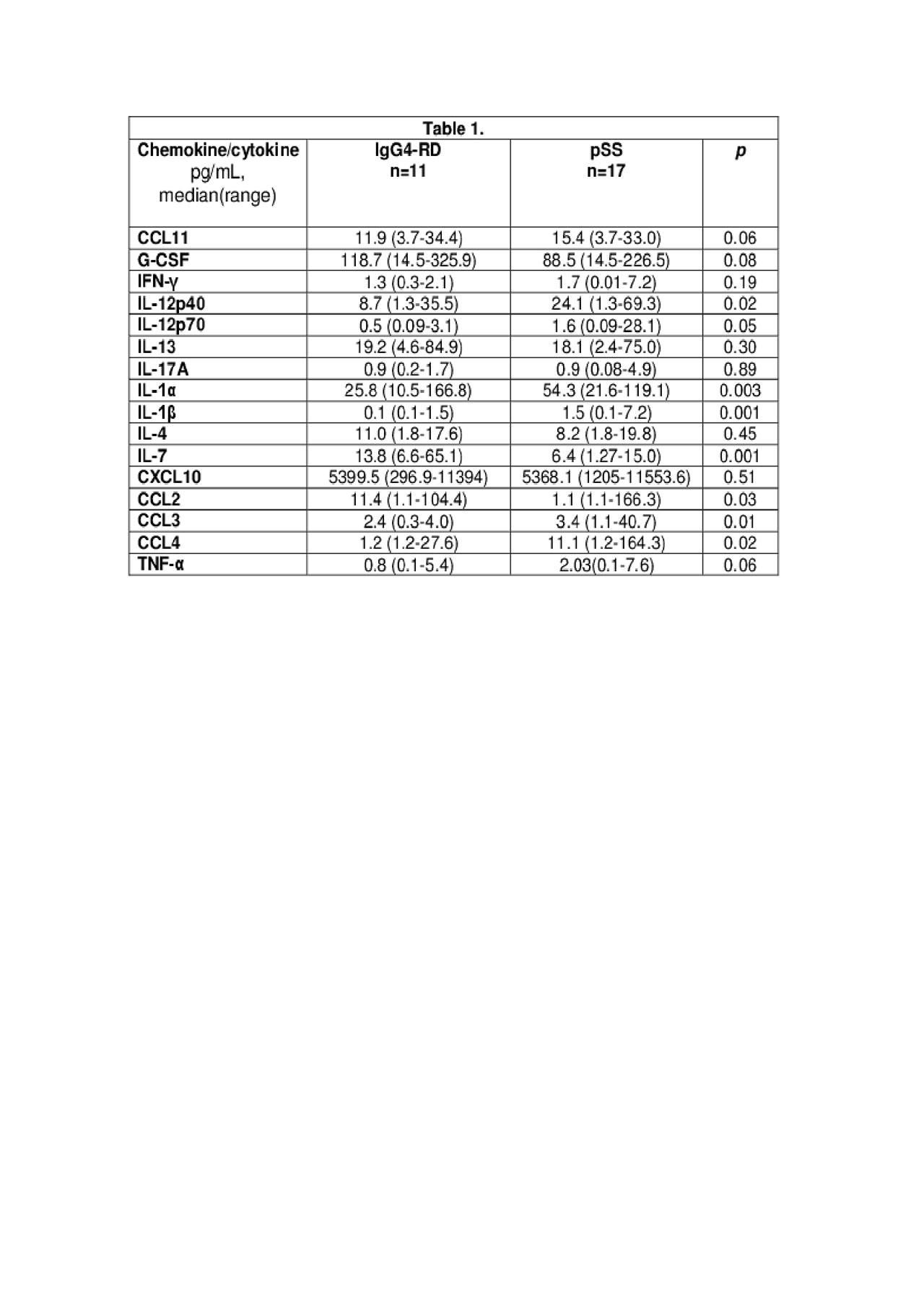Session Information
Session Type: Poster Session (Monday)
Session Time: 9:00AM-11:00AM
Background/Purpose: The lacrimal gland is frequently involved in both IgG4-related disease (IgG4-RD) and Sjögren’s syndrome (SS) and presents with swelling and/or dry eye symptoms. Although a distinct chemokine and cytokine tear profile might distinguish SS from idiopathic dry eye, as of today no study has assessed this issue in IgG4-RD. Our aim was to evaluate and compare a set of chemokine/cytokine in the tears of patients with IgG4-RD and primary SS.
Methods: We included 11 patients with IgG4-RD according to the Comprehensive Diagnostic Criteria for IgG4-RD and 17 with primary SS according the AECG criteria, who attended a tertiary referral center in Mexico City. Schirmer-I test were performed using two standardized sterile tear strips, and then immediately frozen at -86°C until assayed. Once defrosted, the tears were extracted from the strips using a buffer containing 0.5 M NaCl and 0.5% Tween-20. Then, the amount (pg/mL) of the following selected chemokines and cytokines were measured by Luminometry: CCL11, G-CSF, IFN-γ, IL-12p40, IL-12p70, IL-13, IL-17A, IL-1α, IL-1β, IL-4, IL-7, CXCL10, CCL2, CCL3, CCL4 and TNF-α.
Results: Patients with IgG4-RD were younger (51.3±14.7 vs. 55.7±10.6) and more frequently men (45.5% vs. 5.9%) than SS patients. Regarding the IgG4-RD group, 7 (63.6%) had lacrimal gland involvement, 5 (45.5%) dry eye symptoms and 6 (54.5%) positive Schirmer-I test. We observed multi-organic involvement in 9 patients (81.8%), median number of involved organs of 5, 9 (81.8%) patients had active disease, median IgG4-RD responder index of 6 points, 8 (72.7%) patients had high IgG4 serum levels, and 9 (81.8%) biopsy proven diagnosis. We found higher levels of IL-7 and CCL2, and a trend for G-CSF in the IgG4-RD group. Conversely, primary SS patients had higher levels of IL-12p40, IL-1α, IL-1β, CCL3 and CCL4. At the logistic regression analysis, the variables that remained associated with IgG4-RD were IL-7 (OR 1.43 95% CI 1.06-1.93, p=0.01) and IL12p40 (OR 0.92, 95% CI 0.84-0.99, p=0.01).
In a sensitivity analysis, including only 7 IgG4-RD patients with dacryoadenitis, we also observed higher levels of IL-7 and G-CSF in the IgG4-RD group vs primary SS
Conclusion: The chemokine and cytokine profile of tears of patients with IgG4-RD is characterized by a mixed immune response (Th1/Th2/Th17) compare with a predominantly Th1 response in primary SS. Our results also suggest a possible role of IL-7 in the pathogenesis of IgG4-RD.
To cite this abstract in AMA style:
Martin-Nares E, Llorente L, Lima G, Hernández-Ramírez D, Chan-Campos I, Saavedra-González V, Hernandez-Molina G. Chemokine and Cytokine Tear Profile of Patients with IgG4-Related Disease [abstract]. Arthritis Rheumatol. 2019; 71 (suppl 10). https://acrabstracts.org/abstract/chemokine-and-cytokine-tear-profile-of-patients-with-igg4-related-disease/. Accessed .« Back to 2019 ACR/ARP Annual Meeting
ACR Meeting Abstracts - https://acrabstracts.org/abstract/chemokine-and-cytokine-tear-profile-of-patients-with-igg4-related-disease/

